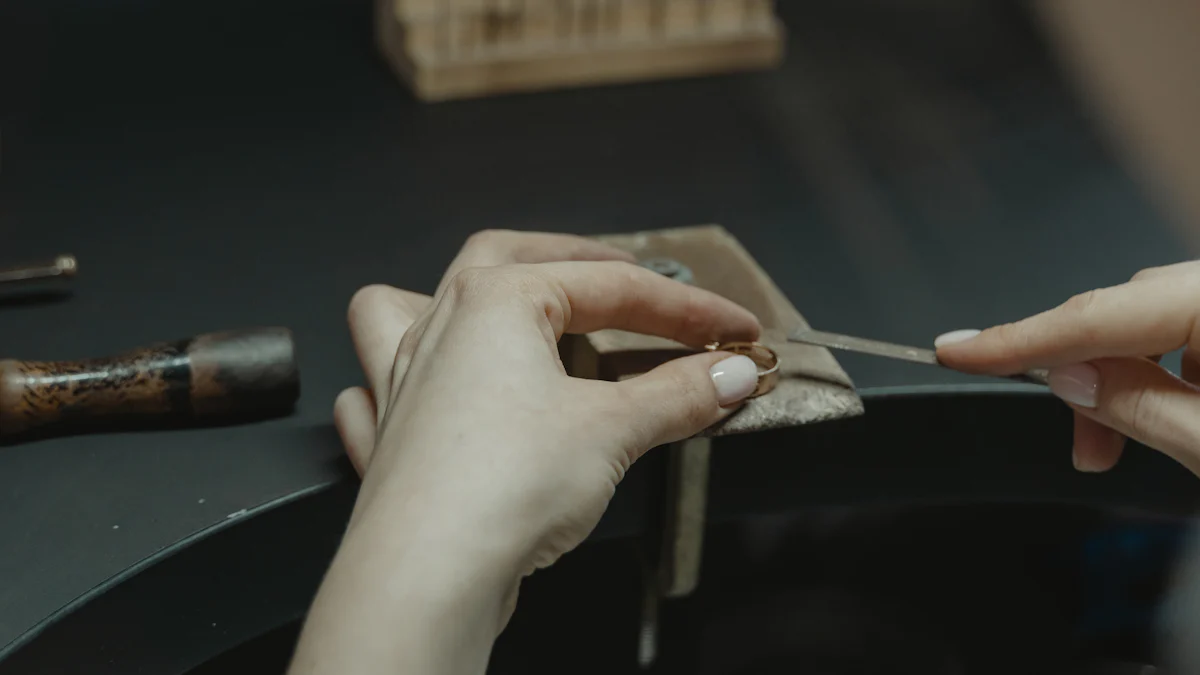T.W Diamond Explained: CT vs TW vs CTTW

When it comes to diamonds, understanding terms like CT, TW, and CTTW is essential. These terms define how diamond weight is measured and presented in jewelry. CT, or carat, refers to the weight of a single diamond, while TW (Total Weight) highlights the combined weight of all diamonds in a piece. CTTW, or Carat Total Weight, represents the total weight of multiple diamonds. Knowing these distinctions helps you evaluate a t.w diamond’s value and brilliance. This knowledge empowers you to make informed decisions when selecting jewelry that matches your style and expectations.
Key Takeaways
- Understand the difference between CT (Carat), TW (Total Weight), and CTTW (Carat Total Weight) to make informed jewelry purchases.
- CT measures the weight of a single diamond, while TW and CTTW represent the combined weight of multiple diamonds in a piece.
- When evaluating multi-stone jewelry, focus on TW or CTTW to assess the overall sparkle and value of the piece.
- Larger diamonds are rarer and more expensive per carat; consider both size and quality when making a purchase.
- Avoid misconceptions: TW and CTTW do not refer to a single diamond's weight but to the total weight of all diamonds in the jewelry.
- Use these terms to compare different jewelry designs effectively, ensuring you choose pieces that align with your style and budget.
What Does CT (Carat) Mean?

Definition of a Carat
A carat, abbreviated as CT, is the standard unit used to measure a diamond's weight. One carat equals 200 milligrams or 0.2 grams. This measurement helps jewelers and buyers understand the size of a diamond. However, carat weight does not directly indicate the diamond's physical dimensions. For example, a well-cut 1-carat diamond may appear larger than a poorly cut diamond of the same weight. The cut, shape, and depth of the diamond all influence its visual size.
When you see a diamond labeled as 1.00ct, it means the diamond weighs exactly one carat. This weight is often associated with engagement rings, as many buyers consider it a classic choice. A 1.00ct diamond offers a balance between size and affordability, making it a popular option for those seeking elegance without exceeding their budget.
How Carat Weight Impacts Diamond Pricing
Carat weight significantly affects the price of a diamond. Larger diamonds are rarer, which makes them more expensive per carat. For instance, a 2-carat diamond will cost much more than two 1-carat diamonds of similar quality. This price increase occurs because larger diamonds are harder to find and cut without imperfections.
The relationship between carat weight and price is not linear. As the carat weight increases, the price per carat rises exponentially. For example, a 3-carat diamond in a solitaire ring will command a much higher price than a 1-carat diamond of the same quality. Buyers often face the dilemma of choosing between size and quality. A smaller diamond with excellent cut and clarity may outshine a larger diamond with visible flaws.
Understanding carat weight helps you make informed decisions when purchasing jewelry. If you're considering a t.w diamond, remember that the carat weight of individual stones contributes to the total weight. For example, a tennis bracelet with 15 diamonds, each weighing 0.2 carats, will have a total weight of 3 carats. This knowledge ensures you can evaluate the value and appearance of the jewelry accurately.
What Does TW (Total Weight) Mean in T.W Diamond Terminology?
Definition of Total Weight
TW, or Total Weight, refers to the combined weight of all diamonds in a piece of jewelry. This measurement includes every diamond, regardless of size, and provides a cumulative total. Unlike CT, which measures the weight of a single diamond, TW accounts for multiple stones. For example, if a ring features three diamonds weighing 0.3 carats, 0.4 carats, and 0.5 carats, the TW would be 1.2 carats.
Understanding TW helps you evaluate the overall value and visual appeal of a jewelry piece. It ensures you know the total diamond weight without focusing on individual stones. This term is especially useful when purchasing items like tennis bracelets, cluster rings, or earrings, where multiple diamonds contribute to the design.
Practical Examples of TW in Jewelry
You often encounter TW in multi-stone jewelry. For instance, a pair of diamond stud earrings might list a TW of 1 carat. This means the combined weight of both diamonds equals 1 carat, with each diamond weighing approximately 0.5 carats. Similarly, a diamond necklace with several small stones might have a TW of 2 carats, indicating the total weight of all the diamonds in the piece.
When shopping for a t.w diamond piece, pay attention to how the weight is distributed. A ring with a TW of 1 carat could feature one large diamond surrounded by smaller ones or several diamonds of equal size. The arrangement affects the jewelry's appearance and how the weight is perceived. By understanding TW, you can make informed decisions and choose pieces that align with your preferences and budget.
What Does CTTW (Carat Total Weight) Mean?
Definition of CTTW
CTTW, or Carat Total Weight, represents the combined weight of all diamonds or gemstones in a piece of jewelry. This term is particularly useful when evaluating multi-stone designs. Unlike CT, which measures the weight of a single diamond, CTTW provides a broader perspective by summing up the weights of multiple stones. For example, a diamond ring with a 1-carat center stone and 36 smaller diamonds totaling 0.25 carats would have a CTTW of 1.25 carats. This measurement ensures you understand the total contribution of all stones to the piece’s overall brilliance and value.
When you see CTTW in product descriptions, it helps you assess the jewelry’s visual impact. A pair of diamond halo earrings, for instance, might feature a 1-carat center stone surrounded by smaller diamonds weighing 0.20 carats. The CTTW of 1.20 carats reflects the combined weight, giving you a clear idea of the piece’s sparkle and elegance. This term simplifies comparisons between different jewelry items, especially when deciding between designs with varying numbers of stones.
When and Why CTTW is Used
Jewelers use CTTW to describe the total weight of diamonds in intricate designs. This term is common in pieces like pavé engagement rings, tennis bracelets, and cluster earrings. For example, a pavé ring with a 0.50-carat center diamond and smaller stones adding up to 0.50 carats would have a CTTW of 1.00 carat. This detail highlights the cumulative weight, helping you evaluate the jewelry’s overall value and appearance.
CTTW proves essential when purchasing multi-stone jewelry. It ensures you understand how the weight is distributed across the piece. A t.w diamond necklace with a CTTW of 2 carats might feature several small diamonds rather than a single large one. This information allows you to choose jewelry that aligns with your preferences, whether you prioritize a bold centerpiece or a design with evenly distributed sparkle.
Understanding CTTW also prevents confusion during your purchase. Some buyers mistakenly assume that CTTW refers to a single diamond’s weight. In reality, it accounts for all stones in the piece. By knowing this, you can make informed decisions and avoid surprises when evaluating jewelry descriptions.
Key Differences Between CT, TW, and CTTW

Side-by-Side Comparison of CT, TW, and CTTW
Understanding the distinctions between CT, TW, and CTTW helps you evaluate diamond jewelry more effectively. Each term serves a unique purpose in describing diamond weight. Here's a clear comparison:
- CT (Carat): Refers to the weight of a single diamond. For example, a diamond labeled as 1.00ct weighs exactly one carat. This term focuses solely on individual stones.
- TW (Total Weight): Represents the combined weight of all diamonds in a piece of jewelry. For instance, a ring with three diamonds weighing 0.3ct, 0.4ct, and 0.5ct will have a TW of 1.2 carats. TW emphasizes the total contribution of multiple stones.
- CTTW (Carat Total Weight): Similar to TW, this term also describes the total weight of all diamonds in a piece. However, CTTW often appears in more detailed descriptions, especially for intricate designs like pavé rings or cluster earrings.
"CTTW and TW both measure the total weight of all diamonds in a piece of jewelry, including side stones or accent diamonds. CT, on the other hand, focuses on the weight of a single gemstone."
While TW and CTTW are nearly interchangeable, CTTW is more commonly used in product descriptions to highlight the cumulative brilliance of multi-stone designs. CT remains distinct by focusing on individual diamonds.
Practical Implications for Buyers
Knowing these differences equips you to make smarter purchasing decisions. Each term provides valuable insights into the jewelry's design and value. Here's how you can use this knowledge:
- Evaluate Individual Stones: If you're looking for a single diamond, focus on the CT measurement. This ensures you understand the size and weight of the primary stone.
- Assess Multi-Stone Jewelry: For pieces like tennis bracelets or cluster rings, pay attention to TW or CTTW. These terms reveal the total weight of all diamonds, helping you gauge the overall sparkle and value.
- Avoid Misunderstandings: Some buyers mistakenly believe TW or CTTW refers to a single diamond. Remember, these terms account for multiple stones. For example, a t.w diamond necklace with a CTTW of 2 carats might feature several smaller diamonds rather than one large stone.
- Compare Designs: Use TW and CTTW to compare jewelry pieces with similar total weights. This helps you decide whether you prefer a bold centerpiece or a design with evenly distributed diamonds.
By understanding these terms, you can confidently interpret jewelry descriptions and choose pieces that align with your style and budget. Whether you're shopping for a solitaire ring or a dazzling multi-stone bracelet, this knowledge ensures you get the best value for your investment.
Common Misunderstandings About CT, TW, and CTTW
Misconception 1: TW or CTTW Refers to a Single Diamond
Many buyers mistakenly believe that TW (Total Weight) or CTTW (Carat Total Weight) refers to the weight of a single diamond. This misunderstanding often leads to confusion when evaluating jewelry. In reality, both TW and CTTW represent the combined weight of all diamonds in a piece. For example, a ring with a TW of 1 carat might feature several smaller diamonds rather than one large stone.
"CTTW is only used to display the total carat weight of all diamonds in a piece of jewelry."
This distinction is crucial when comparing jewelry. A necklace with a CTTW of 2 carats could include dozens of small diamonds, each contributing to the total weight. The visual impact of such a piece differs significantly from a single 2-carat diamond. Understanding this ensures you can accurately assess the design and value of multi-stone jewelry.
When shopping, always ask how the weight is distributed. A TW or CTTW label does not specify the size of individual stones. Knowing this helps you avoid surprises and make informed decisions.
Misconception 2: TW/CTTW Equals the Value of a Single Large Diamond
Another common misconception is that TW or CTTW equals the value of a single diamond with the same weight. This belief can lead to unrealistic expectations about pricing. A 1-carat diamond typically costs much more than a piece with a TW of 1 carat made up of smaller stones. Larger diamonds are rarer and more valuable per carat, which drives their price higher.
"CT TW refers to the total weight of all diamonds in a particular piece of jewelry, emphasizing the importance of differentiating between TW and individual carat weight."
For instance, a tennis bracelet with a TW of 3 carats might consist of 30 small diamonds, each weighing 0.1 carats. The cost of this bracelet will differ greatly from a single 3-carat diamond. Smaller diamonds are more abundant and easier to source, which makes them less expensive per carat.
When evaluating jewelry, focus on both the total weight and the size of individual stones. This approach helps you understand the true value of the piece. By recognizing that TW and CTTW reflect the combined weight of multiple diamonds, you can set realistic expectations and choose jewelry that aligns with your budget and preferences.
Understanding CT, TW, and CTTW is essential for evaluating diamond jewelry effectively. These terms provide clarity on diamond weight, helping you assess the value and brilliance of each piece. While CT focuses on individual stones, TW and CTTW highlight the combined weight of multiple diamonds. Recognizing these differences ensures you make informed decisions when purchasing a t.w diamond. Always consider other factors like cut, clarity, and color to determine overall quality. By mastering these terms, you can confidently interpret jewelry descriptions and select pieces that align with your preferences and budget.
FAQ
What does CT TW refer to in jewelry?
CT TW stands for CT TW. It represents the combined weight of all diamonds in a piece of jewelry.
"CT TW provides clarity on the total weight of diamonds, ensuring you can evaluate the value and design of multi-stone jewelry accurately."
How is CT TW different from individual carat weight?
CT TW measures the total weight of all diamonds in a piece, while individual carat weight focuses on a single diamond. For instance, a solitaire ring with a 1-carat diamond highlights the weight of that single stone. In contrast, a bracelet with a CT TW of 1 carat might include multiple smaller diamond weight.
What does CT TW stand for and how is it used?
CT TW stands for Carat Total Weight or Total Carat Weight. Jewelers use this term to describe the cumulative weight of all diamonds in a piece of jewelry. It is commonly seen in items like tennis bracelets, pavé rings, or cluster earrings. By understanding CT TW, you can assess the overall sparkle and value of multi-stone jewelry.
How do CT TW and CTTW differ from the term "carat"?
CT TW and CTTW both refer to the total carat weight of all diamonds in a jewelry piece. These terms focus on the combined weight of multiple stones. On the other hand, "carat" often refers to the weight of a single diamond. For example, a 1-carat diamond ring highlights the weight of one stone, while a ring with a CTTW of 1 carat might feature several smaller diamonds.
Why is it important to consider factors beyond CT TW when evaluating jewelry?
While CT TW provides valuable information about diamond weight, other factors like cut, clarity, color, and craftsmanship also play a significant role in determining a piece's value. A smaller diamond with excellent cut and clarity can outshine a larger diamond with visible flaws. Always evaluate these additional characteristics to ensure you choose high-quality jewelry.
Can CT TW or CTTW refer to a single diamond?
No, CT TW and CTTW always refer to the combined weight of multiple diamonds in a piece of jewelry. For example, a necklace with a CT TW of 2 carats might include dozens of small diamonds. This measurement does not indicate the weight of a single stone but rather the total weight of all diamonds in the design.
Does a higher CT TW mean better quality?
Not necessarily. A higher CT TW indicates more diamond weight, but it does not guarantee better quality. Factors like cut, clarity, and color significantly influence a diamond's brilliance and value. A piece with a lower CT TW but superior craftsmanship can often appear more stunning than one with a higher CT TW but lower-quality stones.
How can I use CT TW to compare jewelry?
CT TW helps you compare the total diamond weight across different pieces. For example, two rings with a CT TW of 1 carat might look very different depending on how the diamonds are arranged. One ring could feature a single large diamond, while the other might have several smaller stones. Use CT TW alongside other details like design and craftsmanship to make an informed choice.
What should I know about CT TW when shopping for multi-stone jewelry?
When shopping for multi-stone jewelry, pay attention to how the CT TW is distributed. A ring with a CT TW of 1 carat might have one large diamond surrounded by smaller ones or several diamonds of equal size. Understanding this distribution helps you evaluate the piece's visual impact and ensures it aligns with your preferences.
Why do smaller diamonds cost less per carat than larger ones?
Smaller diamonds are more abundant and easier to source, which makes them less expensive per carat. Larger diamonds are rarer and more challenging to cut without imperfections, increasing their value. For example, a 1-carat diamond often costs significantly more than a piece with a CT TW of 1 carat made up of smaller stones.
See Also
Comparing Tungsten Diamond Rings With Traditional Options
A Guide to Diamond Cuts for Engagement Rings
The Importance of Three Stone Diamond Rings Explained

